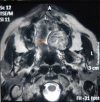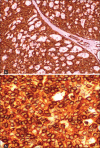Histopathological spectrum of polymorphous low-grade adenocarcinoma
- PMID: 26604510
- PMCID: PMC4611942
- DOI: 10.4103/0973-029X.164555
Histopathological spectrum of polymorphous low-grade adenocarcinoma
Abstract
Polymorphous low-grade adenocarcinomas (PLGA) are distinctive salivary gland neoplasms, with an almost exclusive propensity to arise from the minor salivary glands. PLGA frequently manifests as an asymptomatic, slow-growing mass within the oral cavity, which must be separated from adenoid cystic carcinoma and benign mixed tumor for therapeutic and prognostic considerations. We report a case of a 67-year-old male, who presented with a long-standing mass in the palate. This lesion was diagnosed as PLGA based on histopathological findings, which was further confirmed by the immunohistochemical marker.
Keywords: Adenoid cystic carcinoma; minor salivary glands; polymorphous low-grade adenocarcinoma.
Figures








References
-
- Evans HL, Batsakis JG. Polymorphous low-grade adenocarcinoma of minor salivary glands. A study of 14 cases of a distinctive neoplasm. Cancer. 1984;53:935–42. - PubMed
-
- Freedman PD, Lumerman H. Lobular carcinoma of intraoral minor salivary gland origin. Report of twelve cases. Oral Surg Oral Med Oral Pathol. 1983;56:157–66. - PubMed
-
- Batsakis JG, Pinkston GR, Luna MA, Byers RM, Sciubba JJ, Tillery GW. Adenocarcinomas of the oral cavity: A clinicopathologic study of terminal duct carcinomas. J Laryngol Otol. 1983;97:825–35. - PubMed
-
- Luna MA, Wenig BM. Polymorhpous low grade adenocarcinoma. In: Barnes L, Eveson JW, Reichart P, Sidransky D, editors. World Health Organization Classification of Tumours. Pathology and Genetics of Head and Neck Tumors. 1st ed. Lyon: IARC Press; 2005. pp. 223–4.
-
- Darling MR, Schneider JW, Phillips VM. Polymorphous low-grade adenocarcinoma and adenoid cystic carcinoma: A review and comparison of immunohistochemical markers. Oral Oncol. 2002;38:641–5. - PubMed

